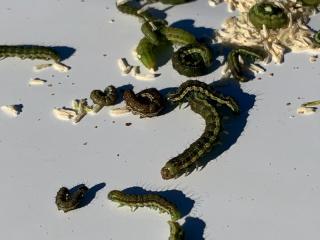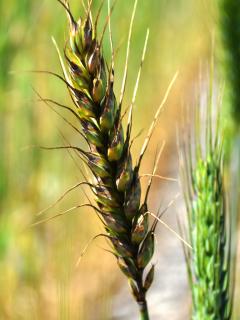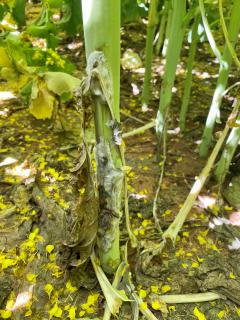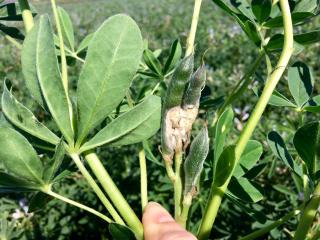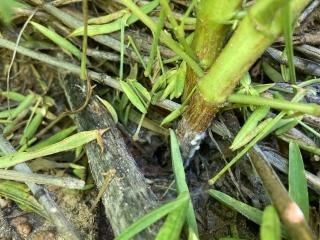Native budworm caterpillars are damaging cereal crops
- Geraldton
- Mullewa
- Tardun
- Mingenew
- Kalannie
- Merredin
- Wongan Hills
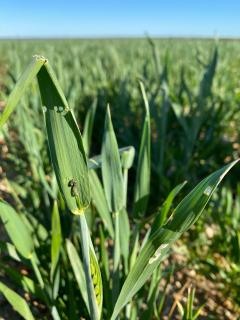
David Stead (Anasazi Agronomy) reports finding a lupin crop at Kalannie which had 3-4 native budworm caterpillars per plant. The crop was at primary pod fill stage and the caterpillars were starting to get into the pods. David also has noticed budworm in cereal crops in the central agricultural region which are causing some concern for growers in regards to what level of damage they are likely to do.
A farmer near Merredin reports finding more than six budworm caterpillars in 10 sweeps in an early flowering field pea crop. The farmer is also finding 10 plus budworm grubs per 10 sweeps in a serradella paddock, while in nearby canola and lupin crops the grub numbers are much lower.
Ty Henning (TekAg) reports finding native budworm in lupin crops north of Kalannie, the budworm caterpillars are causing some feeding damage to the flowers and young lupin pods. Ty also reports finding budworm in some wheat crops near Wongan Hills.
These reports of native budworm grubs doing some damage to lupins pods at this growth stage is unusual as lupin pods will not normally be damaged by native budworm until they are close to maturity and begin to lose their green colouration and leaf fall commences.
Grower Mark Flannagan reports finding 10 – 20 caterpillars per 10 sweeps in wheat crops east of Mullewa. Mark mentioned they were finding 3 to 4 budworm caterpillars per 10 sweeps in their later sown Sceptre wheat and 15 to 30 per 10 sweeps in the more mature Devi wheat. Mark was surprised to find such high numbers as there have been no traditional hosts such as radish or lupins in the area. Radish, canola and lupins are usually needed for the budworm to lay eggs on and build up in numbers.
Two agronomists in the Geraldton area have also reported similar scenarios.
Owen Mann (Nutrien Ag Solutions) has observed damage from budworm on the earlier maturing wheat varieties two to four weeks ago at Geraldton. The majority of damage has now transitioned to later sown or later maturing wheat varieties where the heads are just starting to emerge. This may suggest that late booting to early flowering may be a window of susceptibility.
Caterpillars damage cereal crops by chewing holes in leaves, including the flag leaf, chewing the heads, and sometimes cutting the base of the head or eating and damaging the developing seed.
Thresholds for budworm numbers on wheat haven’t been developed and growers are making judgement calls based on rough estimates of damage to decide if they should spray.
Estimates from agronomists suggest that between 10 to 20% of wheat crops have been sprayed for native budworm north of Mingenew.
Nearly all reports are from budworm damaging wheat. There has been little information coming in to suggest any significant damage on barley and oats.
Grower John Flannagan mentioned a wheat crop at Tardun had high numbers of caterpillars with more than 10 budworm caterpillars per 10 sweeps, while the adjacent lupin crop had only had 1 or 2 per 10 sweeps.
Unusual native budworm activity in cereals
The last three years has seen unusually high numbers of budworm caterpillars found in cereal crops, and although some cases may be the lesser budworm, which is known to damage cereals, many cases have been confirmed as native budworm.
On a number of occasions the presence of confirmed populations of native budworm in cereals has not led to significant crop damage and the budworm numbers have declined over a few weeks. While in other cases there have been reports of significant damage to cereal crops without a confirmed identification of the culprit involved.
In the absence of a cereal crop threshold regular crop monitoring over a period of time to determine whether the budworm population is in decline and an assessment of the overall damage to the cereal crop during the same period is the only way a control decision can be made.
What should you do if you find native budworm caterpillars in cereal crops?
Agronomists or farmers who find native budworm caterpillars in cereal crops causing damage that requires spraying to control the populations are encouraged to forward a caterpillar sample for identification. Please mail samples to one of the following DPIRD staff;
- Alan Lord. 3 Baron-Hay Court, South Perth, WA 6151 on +61 (0)409 689 468.
- Dusty Severtson. 75 York Rd, Northam WA 6401 +61 (0)427 196 656.
- Svetlana Micic. 444 Albany Highway, Albany WA 6330 on +61 (0)427 772 051.
Native budworm moth trapping surveillance
- Usual automated and manual trapping locations
Budworm moth numbers reported by volunteer farmers, agronomists and DPIRD staff have remained low for most of WA’s wheatbelt over the past week. The higher numbers reported this week include Geraldton (17 moths), Varley (10), Walkaway (6), Bindi Bindi (4) and Binnu (4).
A mapped view of the native budworm trap captures is available at cesar’s MothTrapVisWA page. For recent native budworm field reports refer to DPIRD’s PestFax map.
The economic spray threshold levels will vary with crop type, grain price and control cost; these can be calculated for each grower’s particular situation using a simple formula outlined in DPIRD’s Management and economic thresholds for Native Budworm page.
More information on native budworm can be found at DPIRD’s 2020 PestFax Issue 7 article Native budworm and other moths are active and PestFax Issue 10 article Native budworm update. Caterpillars are being found in cereals.
For more information contact Alan Lord, Technical Officer, South Perth +61 (0)8 9368 3758 or +61 (0)409 689 468.
Article authors: Alan Lord (DPIRD South Perth).
Article input: Christiaan Valentine (DPIRD Northam) and Dusty Severtson (DPIRD Northam).
Glume blotch in wheat
- Woorree (Geraldton)
Plant pathologist Ciara Beard (DPIRD) has found glume blotch caused by the pathogen Phaeosphaeria nodorum in Zippy wheat at Woorree, Geraldton. The crop is flowering and the disease has worked its way up from nodorum blotch lesions on the leaves (presence of leaf lesions is a way to distinguish glume blotch from other causes of darkening on wheat heads).
The disease is favoured by warm, wet weather, and severe damage can occur after heavy and frequent rain, such as occurred earlier this month. Heavy infection can result in brown, and later grey, blotching on the ear, leading to shrivelling of grain or complete loss of seed.
Glume blotch is best prevented by application of a registered fungicide when the crop is at grain ear emergence (Z55 - 59) and when the disease is seen moving up the leaves. DPIRD have a trial at the DPIRD Woorree site this year investigating if fungicide application during crop flowering is effective or too late for glume blotch management. It is important to read fungicide labels before application, especially to consider withholding periods.
More information on registered fungicides can be found at DPIRD’s Registered foliar fungicides for cereals in Western Australia page.
Further information about this disease can be found at the department’s Managing yellow spot and septoria nodorum blotch in wheat page.
For more information on wheat diseases contact Kithsiri Jayasena, Plant Pathologist, Albany on +61 (0)8 9892 8477, Geoff Thomas, Plant Pathologist, South Perth on +61 (0)8 9368 3262 or Ciara Beard, Plant Pathologist, Geraldton on +61 (0)8 9956 8504 or Andrea Hills, Plant Pathologist, Esperance on +61 (0)8 9083 1144
Article author: Ciara Beard (DPIRD Geraldton).
Sclerotinia infection in canola and lupin crops
Sclerotinia stem rot in canola
- Greenough
- Walkaway
Plant pathologist Ciara Beard (DPIRD) reports that sclerotinia stem rot has been found in two canola crops at Greenough and Walkaway this week. Last week there was leaf infection evident at both sites where no fungicide was applied and this week it has progressed to stem infection. The Hyola 404 crop at Greenough is at the end of flowering and most of the paddock has been sprayed with fungicide by the grower apart from where a DPIRD opportunistic trial is located. The trial has had a range of timings of fungicide application from 10% to 50% bloom to gather data to compare to the SclerotiniaCM app which has been run for each timing at the site. The stem rot symptoms are being seen in the untreated plots.
A similar experiment being conducted in a Raptor crop at Walkaway has similar symptoms and it is at 60% bloom. Both crops are dense and sown in paddocks that have a history of sclerotinia.
Growers and agronomists are encouraged to use the SclerotiniaCM app to assist decision making on whether to apply a fungicide spray during crop flowering this season. The free app is designed for ipads and android tablets and has been very helpful this year for prioritising paddocks to spray and indicating which ones may not be worthwhile spraying. Before applying fungicide for sclerotinia management growers need to follow guidelines on fungicide labels and ensure the crop is not beyond 50% bloom. For more information refer to DPIRD’s SclerotiniaCM app page.
Further information on sclerotinia management in canola can be found in previous 2020 PestFax Issue 12 Sclerotinia stem rot is being found in canola and Issue 8 Sclerotinia apothecia are being found articles.
Sclerotinia in lupins
- Narra Tarra
- Yandanooka
- Brookton
- Kojonup
Plant pathologist Ciara Beard (DPIRD) reports that sclerotinia infection of pods and branches was recently observed in an Albus lupin crop at Narra Tarra (near Geraldton). The Amira crop is dense, bulky and still flowering while filling pods after a great early start to the season. This area received significant rainfall in early May that most other parts of the Geraldton region missed out on. The grower applied fungicide to the crop at early pod emergence but left some unsprayed strips to gather disease development and yield data in conjunction with DPIRD. The disease symptoms are being seen in the unsprayed area.

Madi George (Mingenew Irwin Group) has recently found sclerotinia in an Albus lupin crop at Yandanooka (near Mingenew). The crop where a MIG and DPIRD in-crop fungicide demo is being conducted with the grower was previously reported in PestFax when apothecia were found under the crop earlier this month. Madi reports finding basal infection on the stem base at ground level on some plants that is causing them to appear wilted. There is also infection showing on pods on some plants, it appears as fluffy white growth.
David Stead (Anasazi Agronomy) has reported finding basal infection in a lupin crop east of Brookton. Capeweed plants in that corner of the paddock were also infected.
Chris Robinson (Farmanco) has reported observing sclerotinia in an Albus lupin crop at Kojonup. A foliar fungicide has been applied to this crop plus an adjacent narrow leafed lupin crop.
DPIRD research has shown that fungicide application prior to or at early stages of disease development can be effective for managing disease in the canopy. Trials have shown that fungicide application should be targeted at early pod emergence stage to protect the pods. However, fungicide is unlikely to provide any control of basal (stem base) infection due to the challenge of canopy penetration and the infection often being at and below ground level.
A list of registered fungicides and rates for lupin sclerotinia can be found at DPIRD’s Registered foliar fungicides for lupin in Western Australia page. It is important to follow label recommendations and observe withholding periods.
For information on the disease in lupin and managing it refer to the 2020 PestFax Issue 11 article Sclerotinia apothecia found in lupins.
For more information on sclerotinia stem rot contact DPIRD Plant pathologists Ciara Beard, Geraldton on +61 (0)8 9956 8504 or Geoff Thomas, South Perth on +61 (0)8 9368 3262
Article author: Ciara Beard (DPIRD Geraldton).

